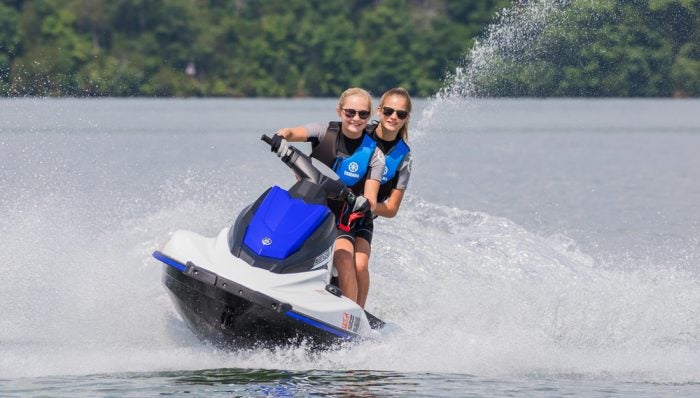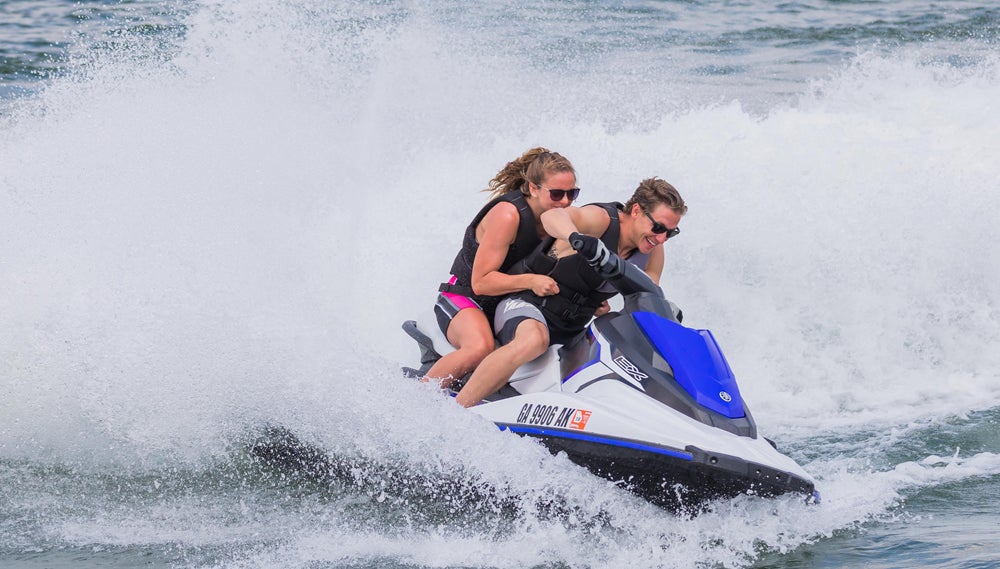2018 Yamaha EX Review
With a price tag of $6,999, the 2018 Yamaha EX is the most affordable model in the WaveRunner lineup, competing directly with the Sea-Doo Spark.
Engine: 1,630cc three-cylinder EFI
Fuel Capacity: 13.2 gal.
Stowage Capacity: 7.7 gal.
Seating Capacity: 3
MSRP: Starting at $6,699
It’s been one year since the Yamaha EX arrived on the scene, entering Yamaha into the still-young Rec Lite category and offering an affordable competitor to Sea-Doo’s Spark. Like the latter craft, the EX proved an instant hit, attracting new buyers into the market as well as existing consumers looking to trade up or add another craft to their fleet.
As expected, a top-selling craft going into only its sophomore season returns pretty much unchanged for 2018. Here’s a reminder of what makes the 2018 Yamaha EX worthy of all the attention.
The New Platform
While the Yamaha EX platform was completely new in ’17, one piece was familiar – the 1,049cc TR-1 engine introduced in 2016. Mildly detuned for the EX (and sisterships EX Sport and EX Deluxe), in this iteration the engine produces an even 100 horsepower. Changes to the existing TR-1 included a smaller, lighter exhaust manifold and muffler and simpler powertrain accomplished through the removal of the pump bulkhead, the integration of the flywheel into the coupler, and a one-piece pump stator and impeller housing. The why was answered last year – cost savings and simpler parts. As to how it’s possible, much of the reason is that the lower horsepower produces less strain on the engine.
The EX’s lower horsepower is matched with a lower weight, a mere 577 pounds. That accomplishment comes via a new hull and deck. The EX is both narrower and shorter than the previous entry-level V1 (the latter dimension a full 9”), and features a simplified design. It lacks the large front storage/rearview mirrors storage hatch that define the FX. The saddle is also narrower and the info display simplified. Storage comes in at 7.7 gallons, divided between a large glovebox, bow tub, and underseat compartment. In this base form, there’s also the absence of reverse. In terms of sheer weight, all combine to lighten the load.
The results are solid acceleration, a 50 mph top speed, and excellent fuel efficiency. (Yamaha claims a 14% advantage over its direct competition in the category.) As to the ride, it’s classic Yamaha. Stability is top-notch on the 2018 Yamaha EX, and the craft can handle three passengers without problem. It’s also capable of hauling a tube or kids on skis. When cutting loose, riders will find a hull that’s playful yet precise, able to spin out like old-school models but still carve an aggressive turn with panache.
Finer Details
Yamaha elected to stay with the same Sheet Molding Compound (a glass-fiber reinforced polyester made in a high-compression mold) material used on their midrange and flagship models. The hull design is actually based on the VX, scaled down to produce the desired results, as well as distinguish the brand’s three model lines. To achieve the narrower saddle design, designers introduced a composite “sub-cowling” that mounts to the SMC deck. The piece allows basic access to the engine for common owner needs – checking oil level, battery condition, or a post-ride rinse down – but can be quickly unbolted for complete engine access.
Other areas where Yamaha elected to not cut corners include HydroTurf traction mats and the now-familiar “pistol” grips that are easier on the hands and offer better control.
As previously stated, reverse is the one big-ticket item missing from the base 2018 Yamaha EX, which retails for $6,699. The Sport model offers mechanical reverse, and the Deluxe gets the full RiDE treatment. I won’t sugarcoat it – you will miss reverse on the base EX. Reverse offers a level of control that takes the stress out of maneuvering tight confines like a dock or launch ramp. Without it, those scenarios can be more like a controlled crash. Sea-Doo follows a similar path with the base Spark. On both craft, however, I’d strongly consider optioning up for the enhanced control.
Speaking of the Spark, it’s the only true head-to-head competitor. Optioned up to the three-passenger model with the 90hp engine and front storage bin to be more of a fair comparison, the Spark runs $6,739.
Get PersonalWatercraft.com in your Inbox!
Like PersonalWatercraft.com on Facebook
Comments
Most Popular

2025 Yamaha JetBlaster PRO 2-Up Review

Remembering the Sea-Doo XP

2024 Kawasaki Jet Ski STX 160X Review

Whatever Happened to the Wetbike?

2017 Kawasaki Jet Ski Ultra 310LX Review



















 Your Privacy Choices
Your Privacy Choices